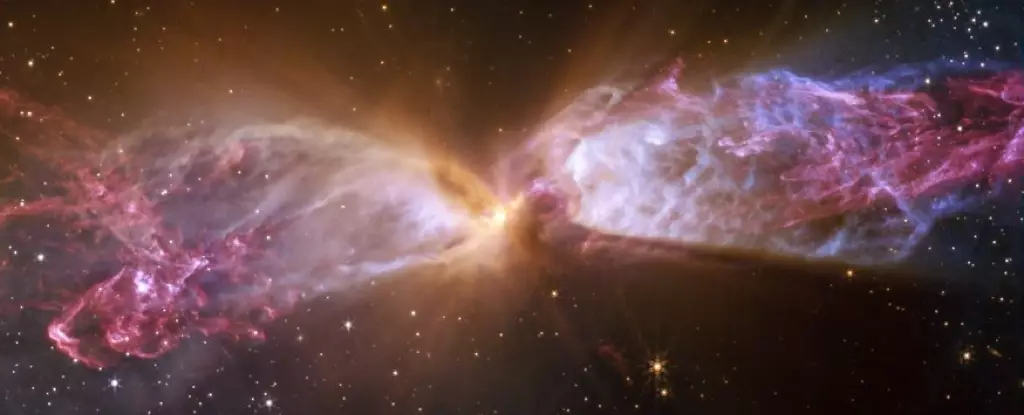The universe is an awe-inspiring canvas teeming with raw, untamed energy. Within this cosmic tapestry, young stars mirror the explosive vigor of childhood, filled with unbridled potential yet often chaotic in their existence. About 650 light-years from Earth, in the dense cloud of gas and dust known as Lynds 483 (L483), two young protostars are currently evolving. The image captured by the James Webb Space Telescope (JWST) resonates with an enticing beauty, showcasing the hourglass shape produced by energetic jets that emerge from these stars, intermingled with colorful swirls of gas and dust—akin to the unpredictable and dynamic spirit of youth.
The birth of stars is a captivating process—akin to the rapid growth of children—as young stars grow by devouring their surroundings. Gathering gas and dust, they silently undergo a metamorphosis that can lead them to achieve astonishing masses, sometimes as much as 200 times that of our Sun. However, this hidden hunger is coupled with the inevitable act of giving back, as protostars expel matter into the cosmos through powerful jets. This duality—a constant ebb and flow of matter—creates a complex lifecycle that is just beginning to unfold.
The Role of the James Webb Space Telescope
When the JWST trained its sensors on L483, it unlocked mysteries that had been veiled by dense clouds of gas and dust. Unlike previous telescopes, the JWST is uniquely equipped to observe in the infrared spectrum, revealing intricate details of celestial phenomena that were once obscured. The dense materials that obscure visible light become transparent in the infrared, allowing this groundbreaking telescope to subject the nascent stars lurking within L483 to precise scrutiny.
The JCWST’s remarkable capabilities afford astronomers a deeper understanding of star formation, particularly the swirling accretion disks surrounding protostars, filled with gas and other materials. As these disks rotate, they form a funneling mechanism that directs matter toward the star’s poles, resulting in the spectacular jets visible in the gorgeous imagery. These powerful jets, propelled by magnetic forces, reach astonishing speeds of several hundred kilometers per second, creating shapes that visibly interact and collide with their surroundings, adding complexity to the visual narrative.
The Dance of Chemical Reactions
One of the most phenomenal aspects of young stars is their contribution to the chemical diversity of the universe. As their jets collide with previously expelled matter, they create an array of lumps and swirls, rich in chemicals essential for building blocks of life, such as methanol and carbon dioxide. A 2019 study highlighted that these chemical reactions predominantly occur within the so-called hot corino—the innermost zone around young stars—emphasizing the vital role protostars play in forging complex organic molecules.
Additionally, we uncover intriguing phenomena in areas where dynamic interactions occur between infalling materials and centrifugal forces. These forces either counteract gravity’s relentless pull or facilitate the formation of structures. Examining these transformational generations of matter provides valuable insights into the history of these young stars and the multitude of possible planetary systems that may eventually emerge from the remnants surrounding them.
Mysteries Wrapped in Dust
At the center of L483 lies a band of thick dust that conceals the young protostars, whose very existence manifests through the influence they exert on their environment. The contrasting orange cones of starlight that emerge above and below this central region unveil the energetic birth of these celestial entities. Yet, the most astonishing aspect is the paired dark cones that represent areas steeped in dense dust, which are testimony to the stubborn resistance of material in scattering light.
Despite this veil of darkness, the JWST’s extraordinary capabilities shine. It reveals background stars illuminating the cosmic canvas beyond L483, and even delineates a previously undocumented structure of filamentous gas and dust—a complex whirlpool of cosmic material that prompts new questions about the early stages of star formation. The varying density appears to be further exemplified by contrasting visuals, signaling there is still much to explore.
Anticipating the Future of Stellar Evolution
The journey of these young stars is just beginning. These primordial protostars won’t reach the main sequence phase of stellar evolution for millions of years, and their transformation into energy-fusing giants will signal the conclusion of the hourglass shapes that dominate now. The beautiful chaos of jets will ultimately be subsumed, ceasing the energetic ejections that define their current state.
While witnessing this beautiful cosmic chaos created by young stars provides a glimpse into the future potential of planetary systems, it also invites ponderings about technological advancements in astronomical exploration. Who can truly envision the future of humanity and the telescopes we could wield eons from now? The unfolding story within L483 is a powerful reminder of the serendipitous nature of discovery and the journey of evolution both in the cosmos and in our own transient lives.

